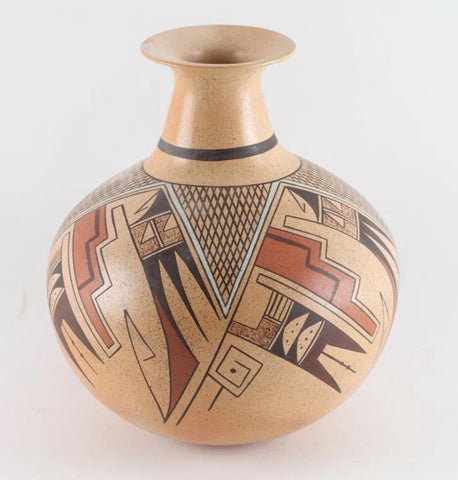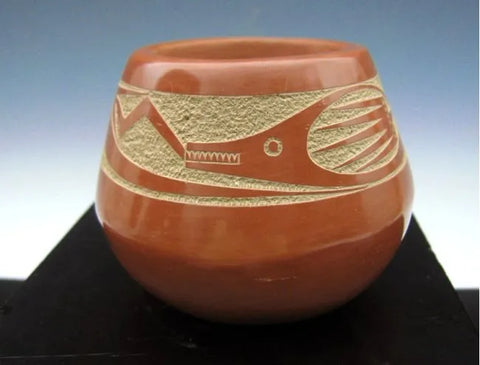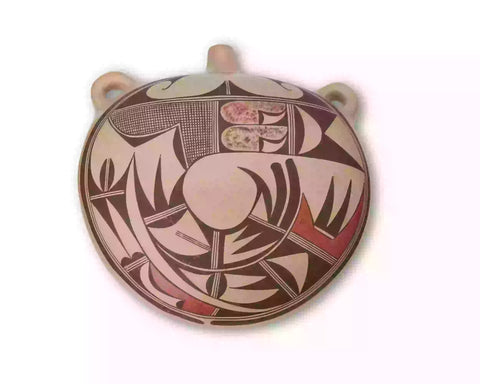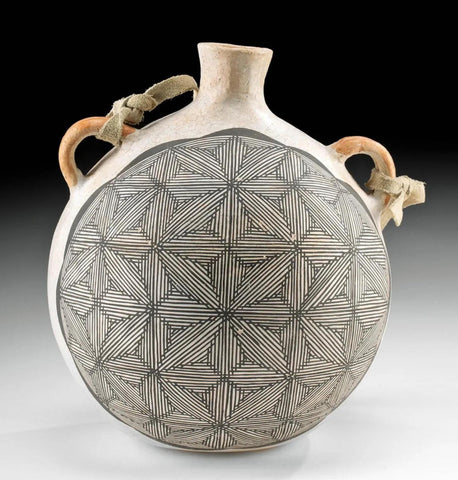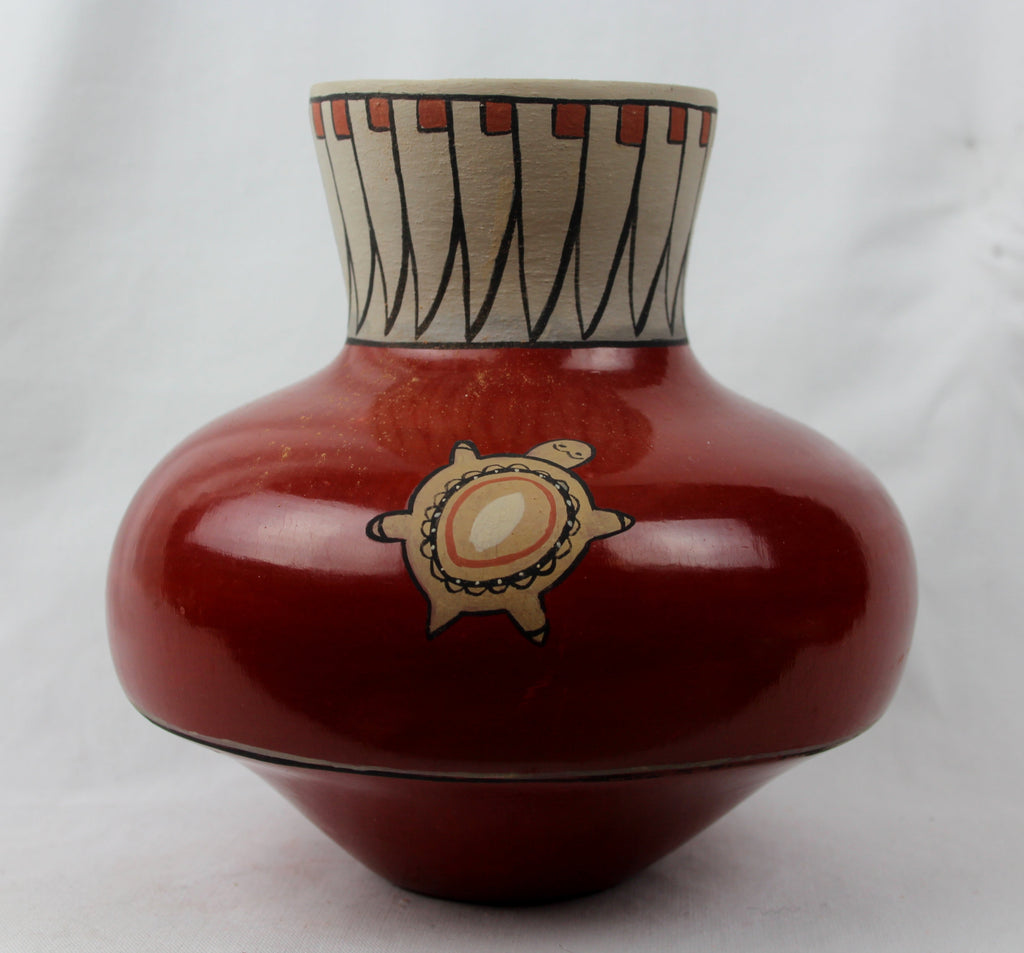
Vintage Pojoaque Pueblo Pottery by Virginia Gutierrez, Ca 1960's, #1278-Sold
$ 708.00
Vintage Pojoaque Pueblo Pottery by Virginia Gutierrez, Ca 1960's, #1278
Discription: #1278 Vintage Pojoaque Pueblo Pottery by Virginia Gutierrez, Ca 1960's, By V. ( Virginia ) Gutierrez born 1941 of the Nambe-Pojoaque Pueblo. She exhibited her work at the Santa Fe Indian Market, now it is hard to find her work on the open market. All her work was hand coiled, pit fired and hand painted with natural pigments.Virginia Gutierrez has not produced much pottery since the 1990s.
Dimensions: 7.0" x 6.5"
Condition: Very good for age.
Pojoaque (/pəˈwɑːkiː/; Tewa: P'osuwaege Owingeh [p’òhsũ̀wæ̃̀gè ʔówîŋgè]) is a census-designated place (CDP) in Santa Fe County, New Mexico, United States. It is part of the Santa Fe, New Mexico Metropolitan Statistical Area. The population was 1,907 at the 2010 census. Pojoaque Pueblo, a neighboring community, is an Indian Reservation, and the town of Pojoaque is a collection of communities near the Pueblo with people from various ethnic backgrounds. The area of Pojoaque includes the neighborhoods of Cuyamungue, Jacona, Jaconita, Nambé and El Rancho.
In the early 17th century the first Spanish mission San Francisco de Pojoaque was founded. During the Pueblo Revolt of 1680, Pojoaque was abandoned, and was not resettled until about 1706. By 1712 the population had reached 79. During the revolt of 1837, New Mexico native Manuel Armijo defeated of the rebels at Puertocito Pojoaque, east of Santa Cruz de la Cañada. In the early 1900s the Pojoaque Valley School District was established to serve the educational needs of the valley.
Pojoaque Pueblo is one of the six Tewa-speaking Rio Grande Pueblos, and a member of the Eight Northern Pueblos. The Pueblo was settled around 500 AD, with the population peaking in the 15th and 16th centuries.
In about 1900, a severe smallpox epidemic caused the pueblo to be abandoned once again by 1912. In 1934, Pojoaque Pueblo was reoccupied, and became a federally recognized Indian Reservation in 1936.[2]
Pojoaque Pueblo remains a major employer in the region, owning several business enterprises, including the gaming operations of three casino locations, Buffalo Thunder Resort, Cities of Gold Casino and Jakes's Casino. Prior to 2017, the New Mexico state gaming compacts signed by the pueblo expired, but the pueblo has continued gaming operations and resumed negotiations with the state of New Mexico.
Pojoaque is located at 35°53′26″N 106°11′34″W (35.890581, -106.009511).[3]
According to the United States Census Bureau, the CDP has a total area of 2.9 square miles (7.5 km²), all land. The Pojoaque River flows from the Sangre de Cristo Mountains from Nambé Lake westward where it flows into the Rio Grande.
As of the census[4] of 2000, there were 1,261 people, 493 households, and 332 families residing in the CDP. The population density was 437.3 people per square mile (169.1/km²). There were 533 housing units at an average density of 184.8 per square mile (71.5/km²). The racial makeup of the CDP was 52.10% White, 0.56% African American, 17.37% Native American, 26.57% from other races, and 3.41% from two or more races. Hispanic or Latino of any race were 62.17% of the population.
There were 493 households out of which 38.3% had children under the age of 18 living with them, 46.7% were married couples living together, 13.0% had a female householder with no husband present, and 32.5% were non-families. 26.6% of all households were made up of individuals and 6.9% had someone living alone who was 65 years of age or older. The average household size was 2.56 and the average family size was 3.10.
In the CDP, the population was spread out with 28.9% under the age of 18, 9.3% from 18 to 24, 30.4% from 25 to 44, 23.3% from 45 to 64, and 8.1% who were 65 years of age or older. The median age was 34 years. For every 100 females there were 103.1 males. For every 100 females age 18 and over, there were 101.3 males.
Discription: #1278 Vintage Pojoaque Pueblo Pottery by Virginia Gutierrez, Ca 1960's, By V. ( Virginia ) Gutierrez born 1941 of the Nambe-Pojoaque Pueblo. She exhibited her work at the Santa Fe Indian Market, now it is hard to find her work on the open market. All her work was hand coiled, pit fired and hand painted with natural pigments.Virginia Gutierrez has not produced much pottery since the 1990s.
Dimensions: 7.0" x 6.5"
Condition: Very good for age.
Pojoaque (/pəˈwɑːkiː/; Tewa: P'osuwaege Owingeh [p’òhsũ̀wæ̃̀gè ʔówîŋgè]) is a census-designated place (CDP) in Santa Fe County, New Mexico, United States. It is part of the Santa Fe, New Mexico Metropolitan Statistical Area. The population was 1,907 at the 2010 census. Pojoaque Pueblo, a neighboring community, is an Indian Reservation, and the town of Pojoaque is a collection of communities near the Pueblo with people from various ethnic backgrounds. The area of Pojoaque includes the neighborhoods of Cuyamungue, Jacona, Jaconita, Nambé and El Rancho.
In the early 17th century the first Spanish mission San Francisco de Pojoaque was founded. During the Pueblo Revolt of 1680, Pojoaque was abandoned, and was not resettled until about 1706. By 1712 the population had reached 79. During the revolt of 1837, New Mexico native Manuel Armijo defeated of the rebels at Puertocito Pojoaque, east of Santa Cruz de la Cañada. In the early 1900s the Pojoaque Valley School District was established to serve the educational needs of the valley.
Pojoaque Pueblo is one of the six Tewa-speaking Rio Grande Pueblos, and a member of the Eight Northern Pueblos. The Pueblo was settled around 500 AD, with the population peaking in the 15th and 16th centuries.
In about 1900, a severe smallpox epidemic caused the pueblo to be abandoned once again by 1912. In 1934, Pojoaque Pueblo was reoccupied, and became a federally recognized Indian Reservation in 1936.[2]
Pojoaque Pueblo remains a major employer in the region, owning several business enterprises, including the gaming operations of three casino locations, Buffalo Thunder Resort, Cities of Gold Casino and Jakes's Casino. Prior to 2017, the New Mexico state gaming compacts signed by the pueblo expired, but the pueblo has continued gaming operations and resumed negotiations with the state of New Mexico.
Pojoaque is located at 35°53′26″N 106°11′34″W (35.890581, -106.009511).[3]
According to the United States Census Bureau, the CDP has a total area of 2.9 square miles (7.5 km²), all land. The Pojoaque River flows from the Sangre de Cristo Mountains from Nambé Lake westward where it flows into the Rio Grande.
As of the census[4] of 2000, there were 1,261 people, 493 households, and 332 families residing in the CDP. The population density was 437.3 people per square mile (169.1/km²). There were 533 housing units at an average density of 184.8 per square mile (71.5/km²). The racial makeup of the CDP was 52.10% White, 0.56% African American, 17.37% Native American, 26.57% from other races, and 3.41% from two or more races. Hispanic or Latino of any race were 62.17% of the population.
There were 493 households out of which 38.3% had children under the age of 18 living with them, 46.7% were married couples living together, 13.0% had a female householder with no husband present, and 32.5% were non-families. 26.6% of all households were made up of individuals and 6.9% had someone living alone who was 65 years of age or older. The average household size was 2.56 and the average family size was 3.10.
In the CDP, the population was spread out with 28.9% under the age of 18, 9.3% from 18 to 24, 30.4% from 25 to 44, 23.3% from 45 to 64, and 8.1% who were 65 years of age or older. The median age was 34 years. For every 100 females there were 103.1 males. For every 100 females age 18 and over, there were 101.3 males.
Related Products
Sold out
Sold out





